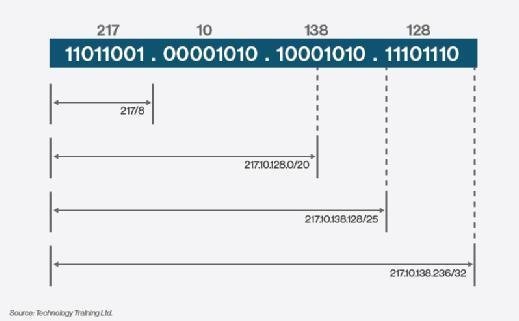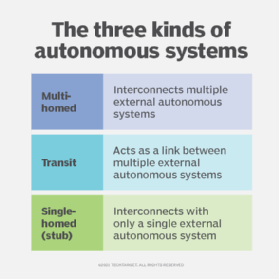autonomous system (AS)
What is an autonomous system (AS)?
An autonomous system (AS) in networking is a collection of one or more associated Internet Protocol (IP) prefixes with a clearly defined routing policy that governs how the AS exchanges routing information with other autonomous systems. In simpler terms, an AS can be thought of as a connected group of IP networks managed by a single administrative entity, such as a university, government, commercial organization or other type of internet service provider (ISP).
What sets the AS apart from other network groups is that it must appear to external autonomous systems that the AS has a single, coherent routing plan, no matter how communications are carried out within the AS.
An AS is sometimes described as a set of routers that are managed by a single administrative entity. The AS appears to other autonomous systems as having a unified interior routing plan that provides a consistent picture of the networks available in that AS.
The autonomous system is structured around IP prefixes and can apply to class A, B or C networks. The term prefix -- when used in conjunction with AS -- is equivalent to a Classless Inter-Domain Routing (CIDR) block, which is a group of IP addresses that share the same prefix and contain the same number of bits. For this reason, an autonomous system is sometimes referred to as a routing domain.

Autonymous systems exchange routing information based on their routing policies, with each AS controlling the IP address space defined by its IP prefixes. In this way, a device in a network in one AS can exchange data packets with a device in a network in another AS.
Consider the following example. The AS1 autonymous system contains the NET1 network, and the AS2 autonymous system contains the NET2 network. After AS1 and AS2 exchange routing information and establish connectivity, a computer on the NET1 network can exchange data packets with a computer on the NET2 network.
Autonomous systems generally fall into one of three categories:
- Multihomed. This is an AS that interconnects with two or more external autonomous systems.
- Transit. This is an AS that acts as a link between two or more external autonomous systems.
- Single-homed (stub). This is an AS that interconnects with only one external AS.

The largest ASes are maintained by Tier 1 ISPs -- ISPs with massive networks. Each Tier 1 ISP maintains its own AS. It owns the network infrastructure and controls traffic flow within that network. Together, these ISPs form the internet backbone. Their AS networks interconnect with each other to create a single internetwork that supports worldwide packet exchanges.
All connections between the Tier 1 ASes are on a noncommercial basis so that packets can pass freely between them. ISPs also help fund internet exchange points -- physical locations that facilitate packet exchange between ISPs and other entities. Tier 2 ISPs typically contract with Tier 1 ISPs to access the internet backbone, and Tier 3 ISPs contract with Tier 2 ISPs, which, in turn, contract with Tier 1 ISPs.
What are autonomous system numbers?
Each autonomous system is assigned a globally unique number called an Autonomous System Number (ASN). The number serves as an identifier for the AS and is used when exchanging routing information with other autonomous systems. ASNs are available in both 16-bit and 32-bit format, although ASNs issued before 2007 were all 16-bit.
An ASN can be either public or private. An AS must have a public ASN to exchange data with other ASes on the internet. When an AS has a public ASN, all routes that originate from the AS are visible to the internet. However, an AS can obtain a private ASN if it communicates with only one provider and it uses Border Gateway Protocol (BGP) to carry out those communications. In this case, the routing policy between the AS and the provider is not visible to the internet.
The Internet Assigned Numbers Authority (IANA) manages the ASN system and coordinates the distribution of ASNs across five global regions. Each region maintains its own regional internet registry, which is responsible for issuing ASNs to individual ASes within that region. The five regional internet registries cover the following territories:
- African Network Information Center, or AFRINIC -- Africa
- Asia-Pacific Network Information Centre, or APNIC -- Asia/Pacific
- American Registry for Internet Numbers, or ARIN -- Canada, USA and some Caribbean Islands
- Latin America and Caribbean Network Information Centre, or ACNIC -- Latin America and some Caribbean Islands
- Réseaux IP Européens Network Coordination Centre, or RIPE NCC -- Europe, the Middle East and Central Asia
Currently, IANA functions are carried out by the Public Technical Identifiers organization, an affiliate of the Internet Corporation for Assigned Names and Numbers, which is now responsible for managing IANA functions.
What is Border Gateway Protocol?
Networks within an autonomous system communicate routing information to each other using one or more interior gateway protocols. In contrast, communications between autonomous systems rely on a single exterior gateway protocol -- Border Gateway Protocol -- which makes it possible to share routing information and efficiently route data packets between autonomous systems. Because BGP plays such a pivotal role, it is sometimes referred to as the routing protocol that keeps the internet running.
BGP is an inter-AS routing protocol that facilitates the exchange of network reachability information between BGP systems. From this information, BGP can direct packets along the most efficient routes to their target autonomous systems.
To carry out these operations, the protocol uses Transmission Control Protocol (TCP) as its transport protocol. Not only does this make BGP compatible with the rest of the internet, but it also eliminates the need for the protocol to perform operations such as explicit sequencing or retransmission. When a TCP connection is formed between two devices, they can exchange messages to confirm the connection parameters.
An AS uses BGP to announce which autonomous systems it can connect to and which IP addresses the AS is responsible for. Routers that participate in BGP communications continuously update each other with the most current routing information. Each BGP router maintains a routing table to store this information.
BGP can then use this information -- along with the ASNs -- to build a forwarding topology that directs packets along the best routes, while avoiding network loops. The protocol adheres to a destination-based forwarding paradigm in which the router forwards a packet based only on the destination address in the IP header. As a result, routing policies must conform to this paradigm.








